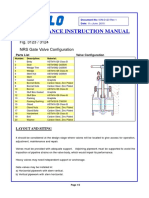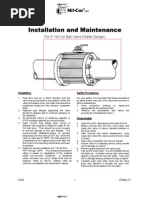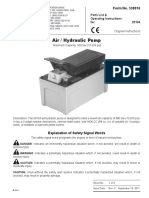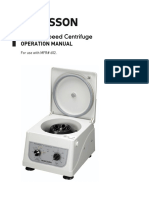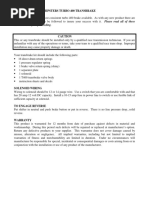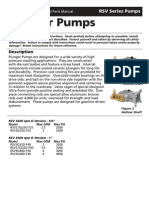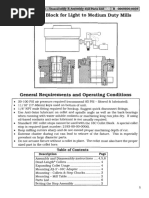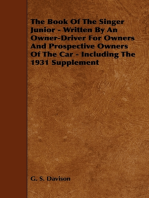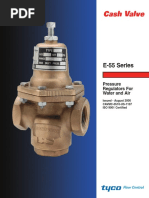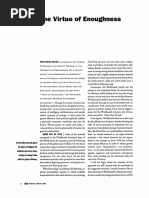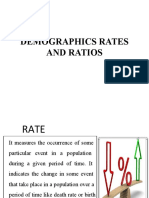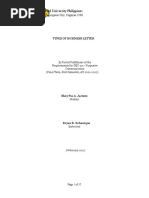Ideal Installation: I & M Mark 68G Series
Ideal Installation: I & M Mark 68G Series
Uploaded by
Byron PanchiCopyright:
Available Formats
Ideal Installation: I & M Mark 68G Series
Ideal Installation: I & M Mark 68G Series
Uploaded by
Byron PanchiOriginal Description:
Original Title
Copyright
Available Formats
Share this document
Did you find this document useful?
Is this content inappropriate?
Copyright:
Available Formats
Ideal Installation: I & M Mark 68G Series
Ideal Installation: I & M Mark 68G Series
Uploaded by
Byron PanchiCopyright:
Available Formats
I & M Mark 68G Series
Installation & Maintenance Instructions for
Mark 68G Pressure Regulators (1/4 2)
3170 Wasson Road Cincinnati, OH 45209 USA
Phone 513-533-5600 Fax 513-871-0105
info@richardsind.com www.jordanvalve.com
Warning: Jordan Valve pressure regulators must only be used, installed and repaired in accordance with these
Installation & Maintenance Instructions. Observe all applicable public and company codes and regulations. In the
event of leakage or other malfunction, call a qualified service person; continued operation may cause system failure
or a general hazard. Before servicing any valve, disconnect, shut off, or bypass all pressurized fluid. Before disassembling a valve, be sure to release all spring tension.
Please read these instructions carefully!
Your Jordan Valve product will provide you with long,
trouble-free service if it is correctly installed and maintained. Spending a few minutes now reading these instructions can save hours of trouble and downtime later.
When making repairs, use only genuine Jordan Valve
parts, available for immediate shipment from the factory.
Ideal Installation
Main Steam Line
4
1
6
R
1 Shut off Valve
2 Pipe Union
3 Strainer and Drain Valve
4 Pressure Gauge
5 Jordan Regulator
6 Relief Valve
7 Steam Trap
Preferred Installation
1.
2.
3.
To protect the valve from grit, scale, thread chips,
and other foreign matter, all pipe lines and piping
components should be blown out and thoroughly
cleaned before the valve is installed.
Shutoff valves, pressure gauges, and bypass piping
should be installed as indicated in the Ideal Installation Schematic to provide easier adjustment, operation, and testing.
In preparing threaded pipe connections, care
should be exercised to prevent pipe sealing compound from getting into the pipe lines. Pipe sealing
compound should be used sparingly, leaving the
two end threads clean. Jordan uses, and recommends, thread sealer Teflon ribbon.
4. A line strainer should be installed on the inlet side of
the regulator to protect it from grit, scale and other
foreign matter. A 0.033 perforated screen is usually
suitable. Line strainers are available from Jordan Valve.
5. Install the regulator in the highest horizontal line of
piping to provide drainage for inlet and outlet piping, to
prevent water hammer and to obtain faster regulation.
6. The flow arrow on the regulator body must be pointed
in the direction of flow. The regulator may be installed
vertically or horizontally without affecting its operation.
7. For best control, 30 straight sections of pipe should
be installed on either side of the valve.
8. In hot vapor lines, upstream and downstream piping
near the regulator should be insulated to minimize
condensation.
9. If possible, install a relief valve downstream from the
valve. Set at 15 psi above the control point of the
regulator.
10. Expand the outlet piping at least one pipe size if the
controlled pressure (downstream) is 25% of
the inlet pressure or less. A standard tapered expander connected to the outlet of the regulator is
recommended.
11. Where surges are severe, a piping accumulator is
recommended.
12. Operate the regulator within its rated pressure and
temperature.
Start-Up
1. Fully open the outlet shut-off valve.
2. Slowly open the inlet shut-off valve.
3. Slowly open and close outlet shut-off valve several
times. This fully strokes the valve to insure satisfactory operation.
4. With outlet shut-off valve open, slowly screw down
adjusting screw until the desired pressure is shown
on the outlet pressure gauge.
5. To change the controlled pressure, turn the adjusting screw clockwise to increase and counter-clockwise to decrease the pressure.
Warning
Diaphragm Replacement
Never substitute a longer length adjusting screw. Personal injury and damage to the valve may result.
Maintenance
WARNING
Be sure that there is no pressure in the valve before
loosening any fittings or joints. The following steps are
recommended:
1. Close the inlet shut-off valve.
2. Allow pressure to bleed off through the downstream
piping. Do not attempt to reverse the flow through
the valve by bleeding pressure from the upstream
side of the valve.
3. When downstream pressure gauge indicates no
pressure in the line, close the outlet shut-off valve.
Refer to the drawing for the proper orientation of the
parts and for proper nomenclature.
Troubleshooting
Erratic Control
Oversizing causes cycling and hunting, and reduces
the rangeability of the regulator. Make certain that
your sizing is correct.
Steam traps downstream may need attention.
Safety valve may be jammed open, disrupting the
system. Repair as necessary.
Excessive foreign matter on seat of plug (3)*.
Clean them. Inspect seating surface on plug for
deterioration.
Valve stroke may not be moving freely. Check stem
(22), bushing (10) or cap bore (2).
1. Remove all pressure from the line as outlined under
WARNING.
2. Remove the compression on the adjusting spring
(14) by rotating the adjusting screw (19) counterclockwise.
3. Remove the spring housing (17). Remove the spring
(14) and spring seat (15).
4. Lift the diaphragm assembly. This diaphragm assembly consists of the upper diaphragm plate (13),
diaphragm (11) and lower diaphragm plate (12).
5. Secure the upper diaphragm plate in a vise. Use a
spanner wrench on the lower diaphragm plate and
turn counter-clockwise to loosen and remove.
6. Remove the diaphragm, clean the parts and install
the new diaphragm in reverse order. Pull the parts
up tight when a metal diaphragm is used. When
elastomer diaphragms are used, clean and degrease
the threads, apply one drop of #290 Loctite to the
threads, and assemble. (Loctite Primer T may be
used to degrease). Thread the parts together, hand
tight, and then tighten 1/8 to 1/4 turn.
7. Clean the diaphragm seating surfaces on the spring
housing (17) and on the body (1).
8. Unscrew the cap (2) approximately two turns to
retract the stem. Place the diaphragm assembly,
spring, spring seat and ball bearing back onto the
valve body. (Metal diaphragms nest into the counterbore in the body).
9. Install spring housing. Tighten bolts (18) evenly per
chart.
10. Thread cap back into the body and pull snug.
Seat and Plug Replacement
Downstream pressure build-up
Seats deteriorated. Inspect for foreign material between plug (3) and seat (9).
Diaphragm (11) failed.
If using metal seats consider using elastomer seats for
tighter shutoff.
Cannot Maintain Regulated Pressure
Clogged strainer or lines.
Inlet pressure low.
Spring (14) set too low or broken.
Valve is undersized for rated flow.
System demand exceeds pump capacity.
* See back page for parts call-out.
-2-
1. Remove all pressure from the line as outlined in the
WARNING.
2. Turn the hex end on the cap (2) counter-clockwise
and remove it from the body. The plug (3) and return
spring (5) will come out with the cap.
3. Remove the seat (9) with a deep drive socket.
4. Inspect parts for wear and replace as required.
5. Clean all parts in the body and on the cap. Lightly
lubricate these surfaces.
6. Reassemble plug spring into cap and check for
smooth operation.
7. Install seat with a light coat of Teflon paste on the flat
seal area and anti-seize to the threads.
8. Install bottom cap onto the body with a light coat
of Teflon paste on the flat seal area and anti-seize
on the threads until it bottoms out on the body and
tighten.
Torque Procedure
5
2
4
3
1
6
7
2
6
3
4
Torque Procedure
Ordering Spare Parts
5
1
8
Use only genuine Jordan Valve parts to keep your valve
in good working order. So that we can supply the parts,
which were designed for your valve, we must know exactly
which product you are using. Please note the following
information on the valves nameplate:
1. Install all bolts hand-tight.
2. Torque the bolts in order of the bolt pattern to a
value equal to 1/4 of the recommended torque
value.
3. Retorque each bolt to the recommended value using the same bolt pattern as shown.
Torque Chart for Spring Housing Bolts
Elastomer Diaphragm
Metal Diaphragm
Bolt Size
Torque
Bolt Size
Torque
5/16
200 in-lbs
5/16
300 in-lbs
3/8
300 in-lbs
3/8
300 in-lbs
-3-
Serial Number
Model and Size
Body Material and End Connections
Range
Diaphragm and Seal Materials
Cross Section View
1 19
20
1
15
21
1
17
Item
Description
Qty
Body
Bottom Cap
Plug Assembly
14
13
10
11
11
18
10
9
22
Return Spring
Orifice (Seat - Std Cv) 3
Bushing
1
1
Diaphragm
12
Lower Diaphragm Plate
13
Upper Diaphragm Plate 1
Range Spring
1
14
12
15
Spring Seat
2
1
17
Spring Housing
18
HHCS
10
19
Adjusting Screw
20
Jam Nut
21
Nameplate
22
Stem
23
Hart Seat
23
3
22
2
Notes:
These items may vary according to range feature
2 20 HHCS fror MK68MP
3 Orifice (seat) is stellited on MK68MP only
4 Soft seat plug assembly - MK68G only
1
Bulletin IM-MK68G-0513
Optional
Soft Seat Trim/Plug Assembly
Seat Detail
3170 Wasson Road Cincinnati, OH 45209 USA
Phone 513-533-5600 Fax 513-871-0105
info@richardsind.com www.jordanvalve.com
You might also like
- A10VSO Repair ManualDocument29 pagesA10VSO Repair ManualAlexandru Ganziuc97% (32)
- S2000 SOS Supercharger Install ManualDocument43 pagesS2000 SOS Supercharger Install ManualMatthew Chtchavlinski100% (4)
- GM Automatic Overdrive Transmission Builder's and Swapper's GuideFrom EverandGM Automatic Overdrive Transmission Builder's and Swapper's GuideRating: 4.5 out of 5 stars4.5/5 (8)
- IOM Manual For CAMAROON Ball ValvesDocument20 pagesIOM Manual For CAMAROON Ball ValvesSathish Kumar Pt100% (2)
- Roots Blower Operating ManualDocument15 pagesRoots Blower Operating Manualanup_nairNo ratings yet
- 5r55e Valve Body SonnaxDocument8 pages5r55e Valve Body SonnaxjoshetoNo ratings yet
- FANCOOLER Maintenance Activities ScheduleDocument8 pagesFANCOOLER Maintenance Activities ScheduleReny RodriguezNo ratings yet
- Enimex - BVFL - GB PDFDocument6 pagesEnimex - BVFL - GB PDFAlienshowNo ratings yet
- Iom WKM 310FDocument4 pagesIom WKM 310FNasir NaqviNo ratings yet
- Cam-Tite Ball Valve Operating Instructions: WarningDocument3 pagesCam-Tite Ball Valve Operating Instructions: WarningSubbarayan SaravanakumarNo ratings yet
- TBV Series 21 20 Cryogenic Flanged Ball ValveDocument5 pagesTBV Series 21 20 Cryogenic Flanged Ball ValveJosip PobranNo ratings yet
- Weflo Nrs Gate Op and MaintDocument5 pagesWeflo Nrs Gate Op and MaintyusufNo ratings yet
- Handling Precautions: Butterfly Valves (Common To All Models)Document9 pagesHandling Precautions: Butterfly Valves (Common To All Models)xaaabbb_550464353No ratings yet
- Pbm-Iom-An5 R1Document4 pagesPbm-Iom-An5 R1jitender.singh29No ratings yet
- Isolation Valve - Watts E3243Document4 pagesIsolation Valve - Watts E3243AHMAD ISLAHINo ratings yet
- Maintenance Instruction Manual: Severe Service Control ValvesDocument9 pagesMaintenance Instruction Manual: Severe Service Control Valvesابزار دقیقNo ratings yet
- Troubleshooting & Maintenance Piston-Type Hydraulic AccumulatorsDocument4 pagesTroubleshooting & Maintenance Piston-Type Hydraulic AccumulatorsqwureyquweryNo ratings yet
- VAAS Fig 740 and 730 Series IOMDocument9 pagesVAAS Fig 740 and 730 Series IOMCarlos GutierrezNo ratings yet
- Sno 450 XRDocument20 pagesSno 450 XRMelvin HrsNo ratings yet
- Aop b3 b6 IomDocument2 pagesAop b3 b6 IomrjNo ratings yet
- 8in Wafer Ball Vale IMODocument2 pages8in Wafer Ball Vale IMOw4uengineerNo ratings yet
- Midland PumpDocument12 pagesMidland Pumppeters petersNo ratings yet
- 3088 Instruction Manual (D) - 230911 - 142910Document20 pages3088 Instruction Manual (D) - 230911 - 142910gguadian21No ratings yet
- FIS113eng Hi Temp BellowsDocument8 pagesFIS113eng Hi Temp Bellowsmahesh_eilNo ratings yet
- Condensate Collection (CCA/CCAF/CCM) and Steam Distribution (MSD/SMSD) Manifolds Installation, Operation and Maintenance InstructionsDocument4 pagesCondensate Collection (CCA/CCAF/CCM) and Steam Distribution (MSD/SMSD) Manifolds Installation, Operation and Maintenance InstructionsMarcial NuñezNo ratings yet
- Manual Mantenimiento Cuadradas Rev.1Document10 pagesManual Mantenimiento Cuadradas Rev.1pelaeztemplarioNo ratings yet
- Plunger Pump Service Manual: Installation and Start-Up InformationDocument6 pagesPlunger Pump Service Manual: Installation and Start-Up InformationSubhendu KarNo ratings yet
- 418 TRIAD-manualDocument55 pages418 TRIAD-manualJUANNo ratings yet
- Iom Cam Ball t31Document20 pagesIom Cam Ball t31Albino Felix HernandezNo ratings yet
- Air Hydraulic Pump OTC EnglishDocument8 pagesAir Hydraulic Pump OTC EnglishEdSoloNo ratings yet
- Maintenance ScheduleDocument16 pagesMaintenance ScheduleSiska0806No ratings yet
- Manual de Usuario de Centrifuge McKessonDocument6 pagesManual de Usuario de Centrifuge McKessonfoxhoundforces100% (1)
- T400BRAKEDocument6 pagesT400BRAKEmanuelvir23No ratings yet
- Welded Body Ball ValveDocument20 pagesWelded Body Ball ValveBisoyiNo ratings yet
- Manual Terex # 55 (Iguana) - 2Document26 pagesManual Terex # 55 (Iguana) - 2Victor Manuel riveraNo ratings yet
- Guidance On Use: Needle Valves & ManifoldsDocument2 pagesGuidance On Use: Needle Valves & ManifoldsRoo FaNo ratings yet
- Presure Washer PumpDocument16 pagesPresure Washer PumpJanet CarmackNo ratings yet
- Pressure Reducing Regulator FISHER Manual Serie 64Document8 pagesPressure Reducing Regulator FISHER Manual Serie 64Billy Isea DenaroNo ratings yet
- Installation Manual - Eaton Model 53BTX SizesDocument6 pagesInstallation Manual - Eaton Model 53BTX SizesGrafton MontgomeryNo ratings yet
- Orifice Flange Union Assembly and Orifice Run Installation and Operation ManualDocument8 pagesOrifice Flange Union Assembly and Orifice Run Installation and Operation ManualNithin CpNo ratings yet
- N2 Triplex Pump-MaintenanceDocument14 pagesN2 Triplex Pump-MaintenanceIbrahim Ahmed100% (1)
- Operating Manual 2006 - 10Document16 pagesOperating Manual 2006 - 10mrmonzonmNo ratings yet
- CHEETAH E-SHIFT Pro Series Valve BodyDocument8 pagesCHEETAH E-SHIFT Pro Series Valve BodyhidraulicNo ratings yet
- Installation of FittingsDocument4 pagesInstallation of FittingsRobert SantiagoNo ratings yet
- Rofi Operation and Maintenance ManualDocument3 pagesRofi Operation and Maintenance ManualSteve NewmanNo ratings yet
- Air CylinderDocument4 pagesAir Cylindersimbua720% (1)
- DC Iom RetainerlessDocument2 pagesDC Iom RetainerlessNicolas Alvarez GomezNo ratings yet
- Low Torc ValveDocument4 pagesLow Torc Valvejinyuan74100% (2)
- Eaton Compressor pump EC 50T -Document8 pagesEaton Compressor pump EC 50T -BenjaminNo ratings yet
- Owner'S Manual: Artmolds' Pressure PotDocument4 pagesOwner'S Manual: Artmolds' Pressure PotAnonymous Wyb8Y1No ratings yet
- RP2Document24 pagesRP2Vennia PapadipoulouNo ratings yet
- Fluidtecq Fluidtecq Fluidtecq Fluidtecq: Operation and Maintenance ManualDocument12 pagesFluidtecq Fluidtecq Fluidtecq Fluidtecq: Operation and Maintenance ManualmehtahemalNo ratings yet
- Saunders HC4 Diaphragm Valves Installation and Maintenance Instructions Manual ValvesDocument6 pagesSaunders HC4 Diaphragm Valves Installation and Maintenance Instructions Manual ValvesJose Gregorio FerrerNo ratings yet
- 6 Way InstructionsDocument2 pages6 Way InstructionsFercho NoriegaNo ratings yet
- Standard Gate Valves ManualDocument8 pagesStandard Gate Valves ManualmechanikyNo ratings yet
- 16C Collet BlockDocument8 pages16C Collet Blockm.asifinterloopNo ratings yet
- The Book of the Singer Junior - Written by an Owner-Driver for Owners and Prospective Owners of the Car - Including the 1931 SupplementFrom EverandThe Book of the Singer Junior - Written by an Owner-Driver for Owners and Prospective Owners of the Car - Including the 1931 SupplementNo ratings yet
- 275HDV High Voltage DetectorDocument5 pages275HDV High Voltage DetectorByron PanchiNo ratings yet
- X-Series Brochure - LTR - AM PDFDocument8 pagesX-Series Brochure - LTR - AM PDFByron PanchiNo ratings yet
- Brochure Secador NVCDocument7 pagesBrochure Secador NVCByron PanchiNo ratings yet
- 2100 sg003 - en P PDFDocument76 pages2100 sg003 - en P PDFByron PanchiNo ratings yet
- MCC AB Guia PDFDocument380 pagesMCC AB Guia PDFT1ran0No ratings yet
- 2100 td032 - en PDocument22 pages2100 td032 - en PByron PanchiNo ratings yet
- Cash Valve E-55 SeriesDocument4 pagesCash Valve E-55 SeriesByron PanchiNo ratings yet
- Compressor Data Sheet Rotary Compressor: Fixed Speed Model Data - For Compressed AirDocument1 pageCompressor Data Sheet Rotary Compressor: Fixed Speed Model Data - For Compressed AirByron PanchiNo ratings yet
- General BICC 279700Document4 pagesGeneral BICC 279700Byron PanchiNo ratings yet
- The Prophets in The History of Salvation and SpiritualityDocument8 pagesThe Prophets in The History of Salvation and SpiritualityEmmanuel ServantsNo ratings yet
- GRAPHSDocument10 pagesGRAPHSAdrian OradaNo ratings yet
- The Virtue of Enoughness - Wolfgang Sachs (1999)Document4 pagesThe Virtue of Enoughness - Wolfgang Sachs (1999)HíldegårdRühstållersdøttírNo ratings yet
- Methods of Computing Vital StatisticsDocument38 pagesMethods of Computing Vital Statisticsvaishali TMU studentNo ratings yet
- Kas Kecil Ni Gusti Ayu Kadek Anggreni SariDocument5 pagesKas Kecil Ni Gusti Ayu Kadek Anggreni SariNi gusti ayu kadek anggreni sari 23 X ipa 3No ratings yet
- Standard Operating Procedure: Darsh Pharmachem Pvt. LTDDocument4 pagesStandard Operating Procedure: Darsh Pharmachem Pvt. LTDNishit SuvaNo ratings yet
- Modal Auxiliary Marginal ModalsDocument18 pagesModal Auxiliary Marginal ModalsNur Alaa MehrathNo ratings yet
- (Trends in Logic Vol. 52) Adam Rieger, Gareth Young - Dialetheism and Its Applications-Springer (2019)Document186 pages(Trends in Logic Vol. 52) Adam Rieger, Gareth Young - Dialetheism and Its Applications-Springer (2019)Ariel JaslinNo ratings yet
- Carried NothingDocument11 pagesCarried NothinggogcanNo ratings yet
- Singular and PluralDocument13 pagesSingular and Pluralpuja dasNo ratings yet
- Lect - 00 - Course InformationDocument16 pagesLect - 00 - Course InformationtrasakroftNo ratings yet
- APBX-IP08-User Manual R V1.4.0-D 20130711-ENDocument49 pagesAPBX-IP08-User Manual R V1.4.0-D 20130711-ENMahmoud AhmedNo ratings yet
- Thoracic Surgery ManualDocument63 pagesThoracic Surgery ManualAhmed Abd El HamedNo ratings yet
- St. Paul University Philippines: Tuguegarao City, Cagayan 3500Document17 pagesSt. Paul University Philippines: Tuguegarao City, Cagayan 3500Sheypia Agustin JacintoNo ratings yet
- Terrier de travail - Alchetron, l'encyclopédie so…Document2 pagesTerrier de travail - Alchetron, l'encyclopédie so…vanellekennelofficielNo ratings yet
- EVS-Yamuna Biodiversity ParkDocument7 pagesEVS-Yamuna Biodiversity ParkSharmishtha SamalNo ratings yet
- Dairy and Food EngineeringDocument105 pagesDairy and Food EngineeringNamraNo ratings yet
- Creative Commons Statistics From The CC Monitor ProjectDocument26 pagesCreative Commons Statistics From The CC Monitor ProjectMike Linksvayer100% (17)
- Government of India Ministry of RailwayDocument23 pagesGovernment of India Ministry of RailwayAnubhav Hem Kumar JainNo ratings yet
- Reasons For Growth of Administrative TribunalsDocument2 pagesReasons For Growth of Administrative TribunalsJuan Cervantes100% (2)
- Carl Rogers (1902-1987) : Humanistic-Existential Paradigm Self TheoryDocument22 pagesCarl Rogers (1902-1987) : Humanistic-Existential Paradigm Self TheoryRhaine EstebanNo ratings yet
- 7.RossWinegar TomGorin - 2023 - WhoNeedsAGoodForecastAnywaysDocument19 pages7.RossWinegar TomGorin - 2023 - WhoNeedsAGoodForecastAnywaysVivekSuthinWeslyNo ratings yet
- Problems of Education in The 21st Century, Vol. 66, 2015Document93 pagesProblems of Education in The 21st Century, Vol. 66, 2015Scientia Socialis, Ltd.No ratings yet
- Retek BusDocument97 pagesRetek BuskevinNo ratings yet
- MainDocument5 pagesMainsohail parachaNo ratings yet
- RTA Spec. - Soil InvenstigationDocument2 pagesRTA Spec. - Soil InvenstigationSheril Chandrabose100% (1)
- TIST Consultancy Services PVT LTD - AMIEDocument3 pagesTIST Consultancy Services PVT LTD - AMIEravindra_bidwaikNo ratings yet
- Aaron Park - Turbo Tax SimulationDocument3 pagesAaron Park - Turbo Tax SimulationaaronhwparkNo ratings yet
- Human Resources DevelopmentDocument16 pagesHuman Resources DevelopmentZahwa DhiyanaNo ratings yet
- CBSE Important QuestionsDocument87 pagesCBSE Important QuestionsPrithvi ranaNo ratings yet












